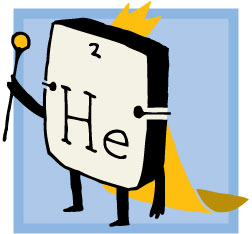Blogging the Periodic Table

The noble gases, which reside on the East Coast of the periodic table, are its aristocrats—detached and aloof, never bothering to interact with the rabble of common elements that make up the vast majority of the world.
If you had to sum up chemistry in one sentence, it might be this: Atoms need to have full shells of electrons to feel satisfied, and different elements steal, shed, or borrow different numbers of electrons to achieve a full shell. That's why chlorine, which needs one more electron for its shell, bonds so nicely with sodium, which has one extra electron, to make sodium chloride, table salt. Each element helps the other, so they form an alliance. In fact, almost all elements form alliances like that.
Not noble gases. They lie, numerically, between the elements that are one electron short and the elements that are one electron over. In other words, they have the perfect number of electrons already, and don't need to form alliances with anything.
This quality makes noble gases (also called "inert gases") intriguing, but their disdain for interacting with regular matter makes them very hard to detect. No one discovered them on Earth until 1894, when British scientists studying the composition of air found an unknown substance, argon. In fact, argon makes up 1 percent of the air we breathe, making it 25 times more common than carbon dioxide. Yet no one knew it existed. Scientists didn't discover the noble gas helium—the second most common element in the universe—on Earth until 1895. And they thought it existed in minute quantities only, until miners found a huge underground cache in Kansas in 1903. They realized they'd discovered something unusual when they tried to light the gas, which was shooting out of a vent in the ground, on fire. To their amazement, it wouldn't catch.
These findings excited many chemists—but presented others, especially those studying the periodic table, with a dilemma. Until then, the table had been seven columns wide. (The metals in columns 3 through 12 of today's table were wedged into other columns at the time.) These seven columns had ordered elements by how they behaved in chemical reactions, and did so quite smartly. So where would these new, nonreactive elements fit?
It didn't help matters that Dmitri Mendeleev, already legendary by the 1890s as the father of the periodic table, was unwilling to accept the noble gases as elements. This rejection of new ideas was something of a pattern with Mendeleev. Like many scientists in his day, he mistrusted anything he couldn't detect with his senses—which meant he also rejected the existence of electrons, radioactivity, and, incredibly, atoms themselves. So it's no surprise Mendeleev had a tough time accepting the colorless, odorless, nonreactive noble gases—especially since they didn't fit into his periodic table.
Still, the table was bigger than Mendeleev by this point. He'd done much to expand and promote the idea, and he deserved his fame. But as a scientific concept the table had become so important to chemistry that many other scientists felt they had a stake in it as well—scientists with fewer hesitations than Mendeleev about strange new gases. Eventually one of those scientists proposed simply tacking a new column onto the edge of the table, extending its width to eight. Really, it could have gone on either side, but it ended up on the right, and that's where it remains.
Given his personality, Mendeleev might have resented this tinkering. But he eventually saw the sense in it. In fact, he used the new structure as propaganda, promoting the new column as the surest vindication yet of his periodic system. The rest of the table had escaped unscathed, after all, and any great scientific theory must be able to fold in new observations. The periodic table had succeeded in this, enduring its brief crisis over the noble gases with grace, and emerging as the unquestionable scientific icon we know today.